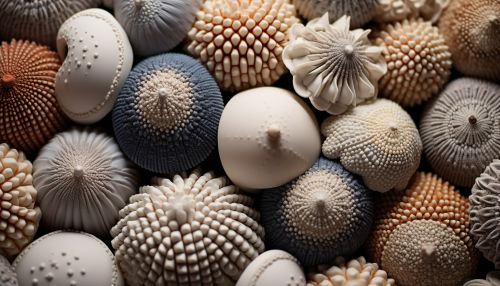Foraminifera
Introduction
Foraminifera, often referred to as "forams," are a large group of amoeboid protists characterized by their intricate and unique shells, known as tests. They are among the most abundant microorganisms in the oceans and play a significant role in the marine ecosystem. Their tests, often made of calcium carbonate, are used in various fields of study, including paleoclimatology and biostratigraphy.


Classification and Diversity
Foraminifera belong to the kingdom Protista, and the phylum Foraminifera. They are further divided into two classes: the benthic foraminifera, which live on or near the seafloor, and the planktonic foraminifera, which float in the water column. Each class is further divided into orders, families, genera, and species, with over 10,000 species identified to date.
Morphology
Foraminifera are unicellular organisms, but they are far from simple. They have a complex internal structure, with a cytoplasm divided into two parts: the endoplasm and the ectoplasm. The endoplasm is the inner part of the cell, while the ectoplasm is a thin layer that surrounds it. The ectoplasm extends through openings in the test to form pseudopodia, which are used for locomotion and feeding.
Test Structure
The test, or shell, of a foraminiferan is its most distinguishing feature. It can be composed of various materials, including calcium carbonate, agglutinated sediment, or organic compounds. The test's structure and composition are used to classify foraminifera and can provide valuable information about the environment in which they lived.
Life Cycle
Foraminifera have a complex life cycle that includes both asexual and sexual reproduction. They typically start as a single cell, which divides to form a small colony. This colony eventually breaks apart, and the individual cells grow and develop into adults. Adult foraminifera can reproduce sexually, producing gametes that combine to form a zygote, which then develops into a new colony.
Ecological Role
Foraminifera play a crucial role in the marine ecosystem. They are primary consumers, feeding on algae and other microorganisms, and are a significant food source for many marine animals. They also contribute to the carbon cycle by sequestering carbon in their calcium carbonate tests.
Fossil Record
Foraminifera have a rich fossil record dating back to the Cambrian period, over 500 million years ago. Their tests, which are often well-preserved in sedimentary rocks, provide valuable information about past climates and environments. They are also used in oil exploration, as certain species are associated with specific geological periods and environments.
Human Impact
Human activities, particularly those related to climate change and ocean acidification, have a significant impact on foraminifera. Changes in sea temperature and pH can affect their distribution, abundance, and diversity, with potential knock-on effects on the marine ecosystem.
